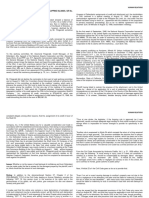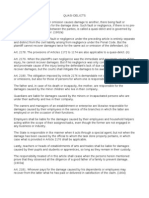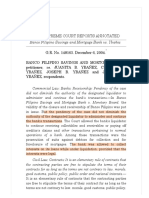PLDT v. CA
PLDT v. CA
Uploaded by
Katrina FregillanaCopyright:
Available Formats
PLDT v. CA
PLDT v. CA
Uploaded by
Katrina FregillanaCopyright
Available Formats
Share this document
Did you find this document useful?
Is this content inappropriate?
Copyright:
Available Formats
PLDT v. CA
PLDT v. CA
Uploaded by
Katrina FregillanaCopyright:
Available Formats
FREGILLANA, Katrina Dominica C.
PRINCIPLE: The negligence of the plaintiff is the proximate cause of his injury.
Provision: Art 2179 (New Civil Code of the Philippines)
When the plaintiff’s own negligence was the immediate cause of his injury, he cannot recover
damages. But if his negligence was only contributory, the immediate and proximate cause of
the injury being the defendant’s lack of due care, the plaintiff may recover damages, but the
courts shall mitigate the damages to be awarded.
PLDT V. CA
G.R. No. L-57079
September 29, 1989
Facts: In the evening of July 30, 1968 spouses Antonio Esteban and Gloria Esteban sustained
injuries when their jeepney ran over a mound of earth. The said construction is being
undertaken by Philippine Long Distance Telephone Company (PLDT). Gloria Esteban
sustained injuries on her arms, legs, and cheeks which eventually left a permanent scar on her
cheek. While Antonio Esteban sustained a cut in his lips and in addition to that the
windshield of their jeepney was also smashed. Spouses Esteban filed a complaint against
PLDT, the one in charge of the construction. It was alleged in the complaint that Antonio
Esteban failed to notice the accident mound due to the lack of warning signs and warning
lights. PLDT contended that they are not responsible for the injuries sustained by the spouses
by reason that the excavation is the undertaking of L.R. Barte and the proximate cause of the
injuries is the negligence of Antonio Esteban.
Issue: Whether or not the proximate cause of the injury is the negligence of Antonio Esteban.
Held: Yes, the proximate cause of the injuries is the negligence of Antonio Esteban. The
reason for the injuries would be the unexplained swerving of Esteban. If only Esteban
remained in the inner lane and did not swerve from the left, he would not hit the accident
mound. He also claimed that he was running 25 kph, but it was proved by sufficient evidence
that he was not running at such speed. He could have avoided the mound if he was indeed
running at 25 kph for he will be able to hit the brakes in which the doctrine of the last clear
chance may apply. It was clear enough that Antonio Esteban failed to observe due diligence.
It was also taken into consideration that the spouses were residents of Lacson Street,
therefore they are aware of the ongoing excavation within their vicinity. In addition to that,
the accident mound was relatively visible therefore Esteban cannot claim that he did not see
such.
You might also like
- LAW OF CONTRACT IN TANZANIA (Part 1) by MWAKISIKI MWAKISIKI EDWARDSDocument62 pagesLAW OF CONTRACT IN TANZANIA (Part 1) by MWAKISIKI MWAKISIKI EDWARDSMWAKISIKI MWAKISIKI EDWARDS89% (100)
- Petition For InclusionDocument4 pagesPetition For InclusionRitch Viñas75% (4)
- Case Digest 221 224254Document3 pagesCase Digest 221 224254Ronee Javier TababaNo ratings yet
- Damages - Vestil Vs IacDocument2 pagesDamages - Vestil Vs IacTea AnnNo ratings yet
- Firestone vs. Ca GR No. 113236Document2 pagesFirestone vs. Ca GR No. 113236REA RAMIREZNo ratings yet
- Rogelio Nogales V. Capitol Medical CenterDocument3 pagesRogelio Nogales V. Capitol Medical CenterAl-husaynLaoSanguilaNo ratings yet
- 12 Lambert v. Heirs of CastillonDocument13 pages12 Lambert v. Heirs of CastillonBerNo ratings yet
- Indiana Aerospace University V Commission On Higher EducationDocument2 pagesIndiana Aerospace University V Commission On Higher EducationRealKD30100% (1)
- Jimenez vs. City of Manila (PubCorp Case Digest6)Document1 pageJimenez vs. City of Manila (PubCorp Case Digest6)Robert Lavina100% (1)
- Engracio Fabre, Jr. vs. Court of AppealsDocument3 pagesEngracio Fabre, Jr. vs. Court of AppealsAlvin ClaridadesNo ratings yet
- 379 - Vector Shipping v. American Home., 3 July 2013Document2 pages379 - Vector Shipping v. American Home., 3 July 2013Reynaldo Lepatan Jr.No ratings yet
- 1 Kauffman Vs PNB (42 Phil 182, 29 September 1921)Document5 pages1 Kauffman Vs PNB (42 Phil 182, 29 September 1921)Lira HabanaNo ratings yet
- 6 Industrial Finance Corp v. TobiasDocument9 pages6 Industrial Finance Corp v. TobiasMlaNo ratings yet
- Ylarde V AquinoDocument1 pageYlarde V AquinoAnton GabrielNo ratings yet
- Inec Vs CA G.R. No. L-53401Document9 pagesInec Vs CA G.R. No. L-53401Veepee PanzoNo ratings yet
- Insurance CasesDocument12 pagesInsurance CasesMohammad AlianNo ratings yet
- Calalas vs. CaDocument1 pageCalalas vs. CaNAT CYRUS B. ASUFRANo ratings yet
- Torts Digest HRDocument5 pagesTorts Digest HRErika Mariz CunananNo ratings yet
- Villarico V Sarmiento DIGESTDocument2 pagesVillarico V Sarmiento DIGESTJaypoll DiazNo ratings yet
- The United States vs. Ignacio CarlosDocument8 pagesThe United States vs. Ignacio CarlosJayzell Mae FloresNo ratings yet
- Heir of Ramon Arce v. DARDocument2 pagesHeir of Ramon Arce v. DARSandy Marie DavidNo ratings yet
- Labor Case Digest 23-28 REVISEDDocument10 pagesLabor Case Digest 23-28 REVISEDgretchen vasquezNo ratings yet
- Estrada vs. Escritor PDFDocument129 pagesEstrada vs. Escritor PDFLorna PaghunasanNo ratings yet
- GArcia V Thio 154878Document3 pagesGArcia V Thio 154878Cla SaguilNo ratings yet
- Gonzales VsDocument1 pageGonzales VsJosie Jones BercesNo ratings yet
- Bachelor Express V CADocument3 pagesBachelor Express V CAJanWacnangNo ratings yet
- Far Eastern Vs CA 297 SCRA 30Document42 pagesFar Eastern Vs CA 297 SCRA 30kheriane veeNo ratings yet
- Cayao-Lasam v. RamoleteDocument1 pageCayao-Lasam v. RamoleteHoreb Felix VillaNo ratings yet
- Pat Digests 002Document4 pagesPat Digests 002Michaela Anne CapiliNo ratings yet
- 13 Cusi-Vs.-PnrDocument7 pages13 Cusi-Vs.-Pnrmichelle_calzada_1No ratings yet
- Kramer VS CaDocument2 pagesKramer VS CaRaamah DadhwalNo ratings yet
- Vda. de Bataclan v. Medina, 1957Document1 pageVda. de Bataclan v. Medina, 1957Randy SiosonNo ratings yet
- S2-B2 Cruz vs. CA, 282 SCRADocument1 pageS2-B2 Cruz vs. CA, 282 SCRAMarisse CastañoNo ratings yet
- PERLA COMPANIA DE SEGUROS, INC. and BIENVENIDO S. PASCUAL, PetitionersDocument4 pagesPERLA COMPANIA DE SEGUROS, INC. and BIENVENIDO S. PASCUAL, PetitionersOrlando DatangelNo ratings yet
- GabetoDocument1 pageGabeto.No ratings yet
- Supreme Court: Thos. D. Aitken, For Appellant. Rosado, Sanz, and Opisso, For AppelleesDocument5 pagesSupreme Court: Thos. D. Aitken, For Appellant. Rosado, Sanz, and Opisso, For AppelleesGretch MaryNo ratings yet
- FACTS: at The Height of The Typhoon "Kading", A Flash Flood Covered The Towns NearDocument2 pagesFACTS: at The Height of The Typhoon "Kading", A Flash Flood Covered The Towns NearMarrielDeTorresNo ratings yet
- 3rd Assignment (Battered Woman Syndrome) PDFDocument2 pages3rd Assignment (Battered Woman Syndrome) PDFMatthew ThompsonNo ratings yet
- 24 Valenzuela V CADocument4 pages24 Valenzuela V CALeeNo ratings yet
- Palisoc V BrillantesDocument8 pagesPalisoc V BrillantesBae IreneNo ratings yet
- Delsan Transport Lines Vs C A Construction GR 156034Document5 pagesDelsan Transport Lines Vs C A Construction GR 156034Princess GalangNo ratings yet
- 097 Child Learning Center and Sps Limon v. TagorioDocument2 pages097 Child Learning Center and Sps Limon v. Tagorioalexis_beaNo ratings yet
- CONTRACT OF LEASE MandaluyongDocument5 pagesCONTRACT OF LEASE MandaluyongRegine PalomoNo ratings yet
- Roxas v. CADocument2 pagesRoxas v. CA111111No ratings yet
- #5 Tamargo Vs Court of Appeals 209 SCRA 518Document10 pages#5 Tamargo Vs Court of Appeals 209 SCRA 518Ta Jose100% (1)
- Defences On Negligence TutorialDocument3 pagesDefences On Negligence Tutorialsajetha sezliyanNo ratings yet
- Aggregate Amount of P20,505.00 Despite The Agreement of Extrajudicial SettlementDocument1 pageAggregate Amount of P20,505.00 Despite The Agreement of Extrajudicial SettlementJeliSantosNo ratings yet
- 65-66 Dacillo and Garces CaseDocument4 pages65-66 Dacillo and Garces CaseAisha TejadaNo ratings yet
- Maritime Law CasesDocument2 pagesMaritime Law CasescookiehilaryNo ratings yet
- Quasi DelictDocument3 pagesQuasi Delictjason_escuderoNo ratings yet
- Mckee Vs IACDocument22 pagesMckee Vs IAClance zoletaNo ratings yet
- Andamo V IECDocument8 pagesAndamo V IECMarkKevinAtendidoVidar100% (1)
- Agustin vs. Bacalan 135 Scra 340Document11 pagesAgustin vs. Bacalan 135 Scra 340albemartNo ratings yet
- Case Digest (Calimoso v. Roullo)Document1 pageCase Digest (Calimoso v. Roullo)Pearl GoNo ratings yet
- Ramos Vs CaDocument23 pagesRamos Vs CaRaine VerdanNo ratings yet
- People V InvencionDocument2 pagesPeople V InvencionGillian Caye Geniza BrionesNo ratings yet
- Associated Vs Iya Et AlDocument2 pagesAssociated Vs Iya Et AlAndrea AlegreNo ratings yet
- CLUE: Holographic Will Petitioner: Uy Kiao Eng Respondents: Nixon Lee DoctrineDocument3 pagesCLUE: Holographic Will Petitioner: Uy Kiao Eng Respondents: Nixon Lee DoctrineSienna NacarioNo ratings yet
- September 17, 2022Document22 pagesSeptember 17, 2022Carla DomingoNo ratings yet
- Vestil Vs Iac DigestDocument1 pageVestil Vs Iac Digestkoisean18No ratings yet
- Baliwag Transit v. CADocument9 pagesBaliwag Transit v. CALorelei B RecuencoNo ratings yet
- PLDT V. Ca G.R. No. L-57079 September 29, 1980: Katrina Dominica C. Fregillana 3LM2Document7 pagesPLDT V. Ca G.R. No. L-57079 September 29, 1980: Katrina Dominica C. Fregillana 3LM2Katrina FregillanaNo ratings yet
- Article 297 Termination by EmployerDocument5 pagesArticle 297 Termination by EmployerKatrina FregillanaNo ratings yet
- German Management v. CADocument1 pageGerman Management v. CAKatrina FregillanaNo ratings yet
- Torts-Case Digests-FinalDocument126 pagesTorts-Case Digests-FinalKatrina FregillanaNo ratings yet
- PLDT V. Ca G.R. No. L-57079 September 29, 1980: Katrina Dominica C. Fregillana 3LM2Document7 pagesPLDT V. Ca G.R. No. L-57079 September 29, 1980: Katrina Dominica C. Fregillana 3LM2Katrina FregillanaNo ratings yet
- Torts - Full CasesDocument353 pagesTorts - Full CasesKatrina FregillanaNo ratings yet
- Sy-Quia-Case BriefDocument2 pagesSy-Quia-Case BriefKatrina FregillanaNo ratings yet
- 20 FregillanaDocument2 pages20 FregillanaKatrina FregillanaNo ratings yet
- Interpleader By: Arellano, Rafael Polintan, Rhea 4LM2Document5 pagesInterpleader By: Arellano, Rafael Polintan, Rhea 4LM2Katrina FregillanaNo ratings yet
- Sitel v. CIR-Fregillana-4LM2Document11 pagesSitel v. CIR-Fregillana-4LM2Katrina FregillanaNo ratings yet
- Value Added TaxDocument13 pagesValue Added TaxKatrina FregillanaNo ratings yet
- Non-Life Insurance: Fregillana, Katrina Dominica C. 4LM2 Principles of FinanceDocument23 pagesNon-Life Insurance: Fregillana, Katrina Dominica C. 4LM2 Principles of FinanceKatrina FregillanaNo ratings yet
- Finance ReportDocument4 pagesFinance ReportKatrina FregillanaNo ratings yet
- Final Finance Handout (Non-Life Insurance)Document4 pagesFinal Finance Handout (Non-Life Insurance)Katrina FregillanaNo ratings yet
- David C. Mercado (Chairman)Document3 pagesDavid C. Mercado (Chairman)Katrina FregillanaNo ratings yet
- Faculty of Architecture, Planning and Surveying Bachelor of Estate Management (Hons) Uitm Shah AlamDocument13 pagesFaculty of Architecture, Planning and Surveying Bachelor of Estate Management (Hons) Uitm Shah AlamNayli Abdul RahimNo ratings yet
- Aerial and Dart Seeding: DefactoiasDocument7 pagesAerial and Dart Seeding: DefactoiasramanNo ratings yet
- NSTP Lesson 2 Bill of RightsDocument46 pagesNSTP Lesson 2 Bill of RightsJenina Kaye Mostoles Gravides0% (1)
- Tenants Face Huge Rent Hike: Debts Paid OffDocument28 pagesTenants Face Huge Rent Hike: Debts Paid OffSan Mateo Daily JournalNo ratings yet
- Helmerich & Payne Int. Drilling Co. v. Bolivarian Republic of Venezuela, No. 13-7169 (D.C. Cir. May 1, 2015)Document27 pagesHelmerich & Payne Int. Drilling Co. v. Bolivarian Republic of Venezuela, No. 13-7169 (D.C. Cir. May 1, 2015)RHTNo ratings yet
- Colores Amarillo-Dulce Verde-Alejandra Gris-Karla Café-Edwin Rosa-DenisseDocument2 pagesColores Amarillo-Dulce Verde-Alejandra Gris-Karla Café-Edwin Rosa-DenisseKarla Oliver MaldonadoNo ratings yet
- Chapter 2Document21 pagesChapter 2itchero104No ratings yet
- Smile Junior 2 Unit 1 Lesson4 Family Are Always Together - Part2Document7 pagesSmile Junior 2 Unit 1 Lesson4 Family Are Always Together - Part2Ei LeeNo ratings yet
- Property Charts StudyDocument15 pagesProperty Charts StudyJosh Langdon86% (7)
- THBT Death Sentences For Terorist and Drug Addicted Should Be ImplementedDocument2 pagesTHBT Death Sentences For Terorist and Drug Addicted Should Be ImplementedMega AyuNo ratings yet
- Maqtal-e-Mutahhar - Sufferings of The Prophet's DescendantsDocument276 pagesMaqtal-e-Mutahhar - Sufferings of The Prophet's DescendantsMuzaffar MehdiNo ratings yet
- Skellig Universal Theme EssayDocument2 pagesSkellig Universal Theme Essay18BelleSNo ratings yet
- Pastoral Care PaperDocument10 pagesPastoral Care Paperapi-315229431100% (2)
- Grade 7 Reading Passage 02 23 24Document3 pagesGrade 7 Reading Passage 02 23 24John Francis BookNo ratings yet
- Gaza ENGDocument5 pagesGaza ENGIvan PopovićNo ratings yet
- The Cold War The Cold War The Cold War The Cold WarDocument18 pagesThe Cold War The Cold War The Cold War The Cold WarAnkur BhattNo ratings yet
- Presentation, Analysis and Interpretation of DataDocument3 pagesPresentation, Analysis and Interpretation of DataMaria Melanie MendozaNo ratings yet
- US Code 1182 Chapter 12 - Immigration and NationalityDocument234 pagesUS Code 1182 Chapter 12 - Immigration and NationalityBarbara EspinosaNo ratings yet
- Equitable Pci Banking Corporation V. RCBC Capital Corporation G.R. No. 182248 December 18, 2008 FactsDocument2 pagesEquitable Pci Banking Corporation V. RCBC Capital Corporation G.R. No. 182248 December 18, 2008 FactsLyn Dela Cruz DumoNo ratings yet
- English Reading Comprehension For ESL Students - Comprensión de Lectura en IngléDocument3 pagesEnglish Reading Comprehension For ESL Students - Comprensión de Lectura en IngléCESAR MAURICIO RODRIGUEZNo ratings yet
- Discuss The Theme of The Poem, Five Ways To Kill A Man' by Edwin BrockDocument2 pagesDiscuss The Theme of The Poem, Five Ways To Kill A Man' by Edwin Brockraulrony666No ratings yet
- Cyber Security Awareness Among Social Media Users: Case Study in German-Malaysian Institute (Gmi)Document17 pagesCyber Security Awareness Among Social Media Users: Case Study in German-Malaysian Institute (Gmi)rolandNo ratings yet
- The Hon'ble Supreme Court of Indica: BeforeDocument39 pagesThe Hon'ble Supreme Court of Indica: BeforeSwastik Grover50% (2)
- TEODORO vs. MACARAEG (G.R. No. L-20700) Facts: Termination of The LeaseholdDocument6 pagesTEODORO vs. MACARAEG (G.R. No. L-20700) Facts: Termination of The LeaseholdErimNo ratings yet
- Hvs 2022-2023 Calendar FinalDocument1 pageHvs 2022-2023 Calendar Finalapi-327780807No ratings yet
- Criminal Case 18 of 2020Document8 pagesCriminal Case 18 of 2020Mathea GikunjuNo ratings yet
- A Survey of The Afghan PeopleDocument239 pagesA Survey of The Afghan PeopleFaisal SulimanNo ratings yet
- Banco Filipino Savings and Mortgage Bank v. YbanezDocument14 pagesBanco Filipino Savings and Mortgage Bank v. YbanezArnold BagalanteNo ratings yet






































































































